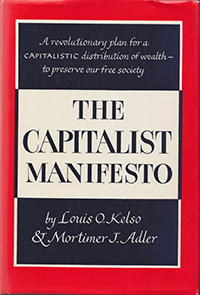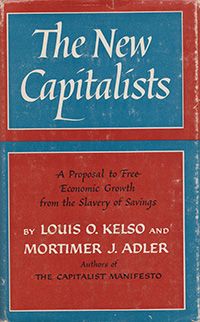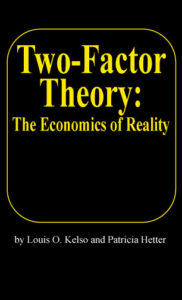 (Download Here)
The Capitalist Manifesto
A Revolutionary Plan for a CAPITALISTIC Distribution of Wealth - to Preserve Our Free Society
(Download Here)
The Capitalist Manifesto
A Revolutionary Plan for a CAPITALISTIC Distribution of Wealth - to Preserve Our Free Society The Capitalist Manifesto and The New Capitalists together comprise the first public statement of Louis Kelso’s seminal contribution to political economics — a thesis Mortimer J. Adler, the co-author, declared “the first clear and systematic statement of the idea of capitalism that has ever been presented to the world.”
Despite its Cold War title, The Capitalist Manifesto of 1958 is neither a defense of traditional capitalism nor a polemical call to revolution in the style of The Communist Manifesto of 1848. It is a theoretical blueprint of the physical and institutional structure of the western private property, free market system identified by Adam Smith and the classical economists, repudiated by Karl Marx and the socialists, and pragmatically compromised by J. Maynard Keynes. It presents specific proposals for correcting and perfecting the present system in the line of, and in the light of, its own logic and principles. It invites men and women of good will to set to work on the task of building an economically just and generally affluent society on the foundation of a Capitalism redeemed of its historical flaws.
Louis Kelso’s vision of Capitalism was, in Dr. Adler’s description, “the economically free and classless society which supports political democracy and which, above all, helps political democracy to preserve the institutions of a free society.” To Dr. Adler’s mind, this conception was “the most revolutionary idea of the century.”
Ten years after his death Louis Kelso is beginning to be recognized as the originator of a genuinely new paradigm in political economics. Although introduced more than forty years ago, its concepts are still virgin terrain because, despite their osmotic influence in the United States, western and eastern Europe, Russia and now China, relatively few people are familiar with them.
Make no mistake, Louis Kelso’s ideas are just as controversial today as when he and Dr. Adler introduced them in 1958. The Austrian economist Schumpeter famously defined Capitalism as “creative destruction.” That is also the effect of a new paradigm on its parent discipline. Louis Kelso’s new paradigm targets, first of all, the conventional premises of economics. But since those premises are also embedded in western political, economic and business institutions, particularly the institutions of finance, Louis Kelso’s binary view exposes the fallacies at their heart as well.
In showing the obsolete ideas at the root of key institutions — the institutions that concentrate wealth and frustrate the operating logic of the free market — Louis Kelso changes the terms of the age-old debate between Conservatives and Liberals and Capital and Labor. And in doing that, he moves to new and higher ground the ideological issues that have made western society a battleground ever since the Industrial Revolution. To understand Louis Kelso’s binary paradigm is to look at the economic and political world with new eyes, from an exhilarating new perspective. The social implications of this new view are revolutionary in the best sense of that word.
Louis Kelso was fascinated by technology. He began his investigation of the Great Depression with painstaking research on the effects of technological change on occupations, industries and the macro-economy. While still in law school, he published a monograph on how the computer, hardly invented then, would revolutionize the practice of law. He eagerly looked forward to the day when the computer would make instantaneous world-wide communication possible. Unfortunately he died a few years before the Internet could make this a reality for him.
Now as we enter the new century and the new millennium, Louis Kelso’s binary economic paradigm is even more important than when first introduced. The demise of the Soviet Union has left the western market economy free to dominate the world on its own terms. Understanding market forces and learning how to exploit them to build stable industrial democracies that are also Good Societies for everyone who lives in them is our most urgent task. Louis Kelso has given us the tools — both conceptual and practical — to accomplish this task. He has also inspired us with his generous vision of the Good Society that advanced technology still promises despite centuries of misunderstanding and misuse.
In gratitude for the life and work of Louis Kelso, and also in honor of his co-author, the late Mortimer J. Adler, whose encouragement and collaboration made these books possible, the Kelso Institute takes great pleasure in electronically publishing both The Capitalist Manifesto and The New Capitalists. In so doing, we fulfill Louis Kelso’s dearest wish in life — that his ideas be made accessible to those who will use them to build institutions that advance civilization and support individuals in realizing their highest potential.
The Economics of Reality

 (Download Here)
(Download Here)

